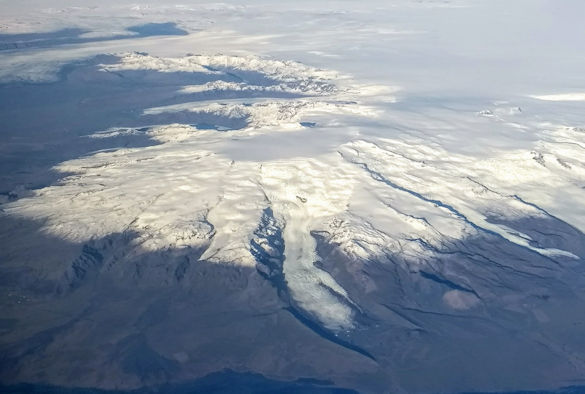
Öræfajökull volcano which is covered by a glacier in SE Iceland
Volcanic eruptions have been known to cool the global climate, but they can also exacerbate the melting of ice sheets, according to a new study involving researchers from the University of Liverpool which is published in the journal Nature Communications.
A team of international researchers analysed ice cores and meltwater deposits to find that ancient eruptions caused immediate and significant melting of the ice sheet that covered much of northern Europe at the end of the last ice age, some 12,000 to 13,000 years ago.
The lead author of the study, Francesco Muschitiello, who was with Columbia University’s Lamont-Doherty Earth Observatory, said: “Over a time span of 1,000 years, we found that volcanic eruptions generally correspond with enhanced ice sheet melting within a year or so,”
These weren’t volcanoes erupting on or near the ice sheet, but located a thousand miles away in some cases. The eruptions heaved huge clouds of ash into the sky, and when the ash fell on the ice sheet, its darker color made the ice absorb more solar heat than usual.
Dr Muschitiello added: “We know that if you have darker ice, you decrease the reflectance and it melts more quickly. It’s basic science.But no one so far has been able to demonstrate this direct link between volcanism and ice melting when it comes to ancient climates.”
The discovery comes from the cross-sections of deposits, called glacial varves, most of which had been collected in the 1980s and 1990s. Varves are the layered sediments that form when meltwater below an ice sheet routes large amounts of debris into lakes near the sheet’s edge. Like the rings of a tree, the layers of a glacial varve tell the story of each year’s conditions; a thicker layer indicates more melting, since there would have been a higher volume of water to carry the sediment.
The researchers also compared the varves to cores from the Greenland ice sheet, whose layers contain a record of ancient atmospheric conditions. Testing of those layers for sulfates revealed which years experienced explosive volcanic eruptions, which tend to release large amounts of ash. Matching up the ice layers with varve layers from the same time periods, the team found that years with explosive volcanic activity corresponded to thicker varve layers, indicating more melting of the northern European ice sheet.
The team studied a period ranging from 13,200 to 12,000 years ago, when the last ice age was transitioning into today’s warm climate. They focused specifically on volcanic eruptions in the northern high latitudes—events similar to the 2010 eruptions of Iceland’s Eyjafjallajökull volcano. Although that eruption was relatively minor, its large ash cloud shut down air traffic across most of Europe for about a week.
Glaciologist and coauthor, James Lea, from the University’s Department of Geography and Planning, said: “It’s difficult to put an exact number to how much melting an eruption like that could cause. . It depends on many factors.”
The Liverpool team were responsible for running thousands of model simulations, which found that the amount of melting depends on the individual eruption, which season it occurs in, the snowpack conditions at the time, and the elevation of the ice sheet.
In the worst scenarios, the model predicted that ash deposition would remove between 20 centimeters and almost one meter of ice from the surface of the highest parts of the ice sheet.
Dr Lea added: “Change any one of these conditions and you would get different amounts of melt. Although there are uncertainties about past climate, we simulated a very broad range of potential conditions so it is likely the ice sheet’s real response lies somewhere within our predicted range.”
The results suggest that present day ice sheets are potentially vulnerable to volcanic eruptions, and also point to a possible issue with the climate models that scientists use to make predictions about the future. Currently these don’t simulate the ice sheets’ response to changes in particulate deposition from the atmosphere in an interactive way, which this study shows to be of potential importance.
Another implication is that previous research has suggested that melting ice sheets and glaciers could increase the frequency of volcanic eruptions in glaciated areas by lightening loads on earth’s crust, allowing underlying magma to rise. If the link between volcanism and ice sheet melting is confirmed, it could indicate the presence of a so-called “positive feedback loop” in which eruptions exacerbate melting, and more melting causes more eruptions, and so on.
The research also involved the University of Quebec in Montrealand and Stockholm University.
The paper, “Enhanced ice sheet melting driven by volcanic eruptions during the last deglaciation,” is published in Nature (doi.org/10.1038/s41467-017-01273-1).